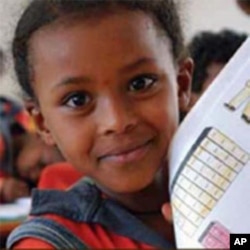As the world prepares to mark the 100th anniversary of International Women’s Day on March 8, a new report details the progress and challenges girls face in getting an education.
The report – from the Education for All Fast Track Initiative – highlights the importance of girls’ education for economic and social development. It follows progress in Ethiopia, Burkina Faso, Ghana, Guinea, Mauritania, Mozambique and Niger.
Prema Clarke, author of Fast-tracking Girls’ Education, says, “Progress for girls’ education is that they can leave their homes, leave their families and come to a place to study and to learn. And that’s a big achievement because otherwise these girls have to stay at home. Look after their siblings. Do the cooking. Do the cleaning.”
She says progress toward the Millennium Development Goals and those of Education for All “is allowing and enabling girls and forcing countries to look at this issue and to ensure that interventions help girls attend school.”
Benefits
Improving education for girls brings many benefits, says Clarke. “It means that girls can then enter the workforce. That they can look after their own families much more effectively. That they can prevent child mortality. They can educate their own girl child when they begin to expand their own families.”
Studies show that having an educated female population helps to improve a country’s health and economic well-being.
Warnings
The report says, “In developing countries, too many girls are not in school, and many girls face continuing health risks, harassment and danger just walking to class.
“Especially in the fragile and post-conflict countries and in many of the African countries this is a real issue,” she says. Till now, the interventions have been so focused on providing schooling and providing teachers, etc. And now I think there is much more expanded focus on looking at specific communities of girls within at-risk groups that now need much more specific attention and much more creative solutions to help them attend school.”
The report calls for “girl friendly policies.”
These, she says, include “mobilizing communities to send their children to school; targeted financial support; the creation of school, health and feeding programs for girls. [And] gender sensitive teacher development. That’s a very crucial issue.”
Clarke says male teachers often discriminate against girl students.
“They expect the boy child to do much better. So, to enable teachers to understand what it means to encourage and help the girl child to learn is very important.”
The report also says girls need to be in a safe environment at school and this includes having the use of restrooms for privacy.
“Then there are, of course, laws and policies that support girls’ education, like clear sanctions against violence, against sexual harassment, drug abuse and employing children,” she says.
Post conflict
Countries that have gone through conflict can pose special challenges to improving girls’ education.
“I know South Sudan really well. And I think there the real problem is there are so few women teachers. So I think there will have to be very targeted incentives for women to join the teaching force, to improve the skill level and knowledge of women teachers already in the system.”
Communities, she says, also need to be educated about the importance of sending girls to school.








